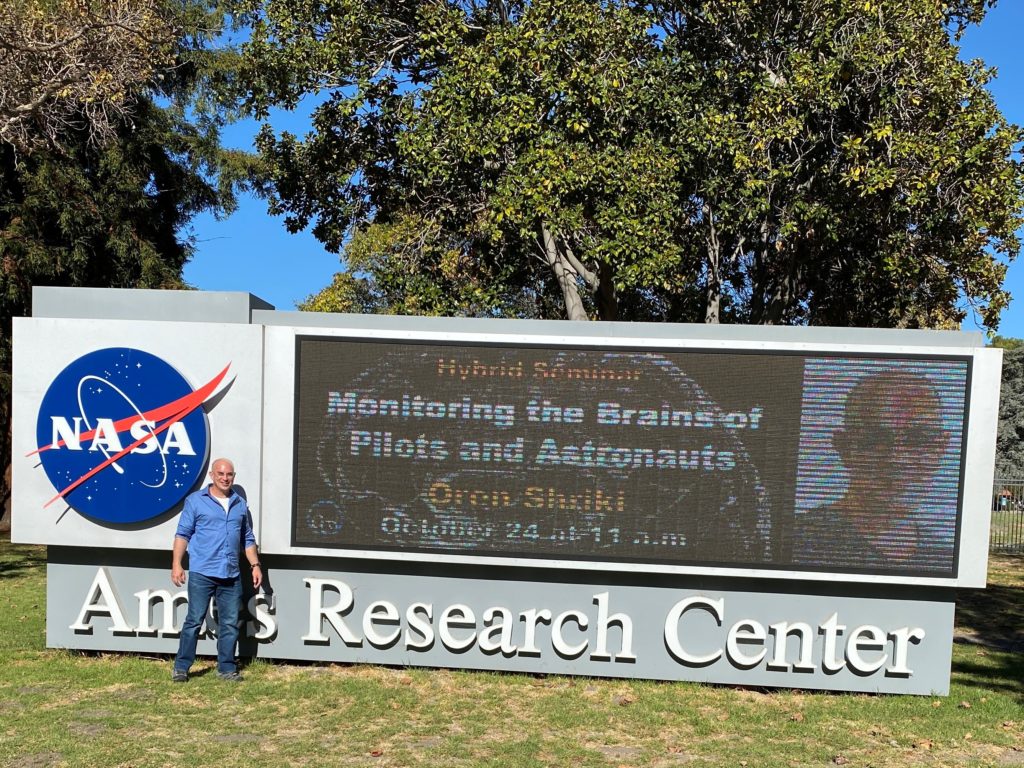
Innovations Give Hope to People with Brain Injuries
Innovations Give Hope to People with Brain Injuries
May 5, 2014
Oregon Jewish Life — The statistics are staggering. Concussions affect as many as 4 million Americans annually. More than 45 million young people involved in sports in the United States incur the risk of a concussion. The cost burden from concussion-related injuries on the healthcare system is estimated at about $17 billion per year in the United States alone.
Because clear markers or tests for concussions have been hard to find, and because loss of consciousness occurs in less than 10 percent of concussions, athletes and others may not know the extent of their injuries, which may last a day, a week or a year. If people go back and play sports before they are fully healed, they can suffer irreversible damage.

President Barack Obama and Prime Minister Benjamin Netanyahu with ElMindA founder, BGU Prof. Amir Geva (left), and CEO Ronen Gadot
BGU researchers have come up with answers for that and other traumatic brain injuries. From the University’s Zlotowski Center for Neuroscience and other departments at the Marcus Family Campus in Beer-Sheva, these researchers have developed partnerships with companies in Israel, the United States and elsewhere.
ElMindA, a BGU spinoff headquartered in Herzliya, Israel, has developed a 40-minute test based on brain mapping and imaging to detect and manage injuries from concussions and other brain-related disorders. The company was founded by Prof. Amir Geva of BGU’s Department of Electrical and Computer Engineering, and was showcased at a technology fair in Jerusalem on the occasion of President Barack Obama’s visit to Israel last year.
ElMindA’s Brain Network Activation (BNA) system uses a hairnet-like cap with attached electrodes to do noninvasive recordings of multichannel electrocephalography event-related potentials. After acquiring the data, the system performs a comprehensive multidimensional analysis of the recordings.
“Traditional tests are inconclusive and no better than talking to a patient,” explains Dalia Dickman, Ph.D., vice president of clinical and regulatory affairs at ElMindA.
“This test is much like an X-ray of a broken bone to determine whether there is a concussion,” she adds.
“Pain measurement is subjective. Now we can score it, see what the baseline is and whether drug therapy or other treatment improves the patient’s condition.”
In a collaboration of ElMindA and the University of Pittsburgh Medical Center Sports Medicine Concussion Program, researchers have evaluated 112 children with and without concussions, looking at their brain activity at four post-injury timeframes. The research confirmed that BNA differentiated between people with concussions and people in a control group, showed a recovery pattern over time and distinguished between types of concussions.
Meanwhile, Step of Mind, a company founded by Dr. Simona Bar-Haim, director of BGU’s Laboratory of Rehabilitation and Motor Control, is helping patients with cerebral palsy, stroke and brain injury to relearn how to walk.
A physiotherapist with a Ph.D. in neurophysiology, Dr. Bar-Haim developed the idea of using chaos theory to facilitate motor learning. Chaos theory is a scientific concept positing that some systems in nature behave in chaotic, non-linear ways, rather than working in a constant predetermined manner.
“Walking is a function of rhythmical movement and an adaptation to overcome obstacles,” explains Dr. Bar-Haim.
“Brain damage is asymmetrical. Because the amount of damage is different in each hemisphere, the person’s legs are functioning differently from one another.”

Dr. Simona Bar-Haim in her lab with the split-tread treadmill
Working with the pharmaceutical company Merck, Dr. Bar-Haim and her colleagues are performing a study called “Middle East Stepping Forward,” in which children and teens with cerebral palsy walk on a split treadmill that operates at two different speeds. Because one belt moves at two kilometers per hour and the other at four kilometers per hour, the subject is walking at a different speed on each leg.
This technology perfectly suits Dr. Bar-Haim’s chaos theory strategy. Given a changing, random situation, the brain in effect bypasses its accustomed motor controller.
Based on the same principle that alters the angle of walking, Step of Mind produces high-technology shoes that physical therapists can use to train patients with brain damage to walk again. The special shoes are used in rehabilitation facilities at the Reuth Medical Center in Tel Aviv and at a clinic in Turkey.
They are sold in both countries, and the company is negotiating with companies in France and the United States. Step of Mind was one of 16 Israeli companies chosen by the Merage Institute in Irvine, California, to make a presentation to American investors.
Read the full article by Ilene Schneider on the Oregon Jewish Life website >>



